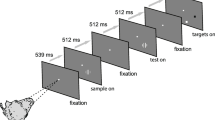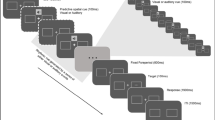Summary
Four normal human subjects were investigated for evidence of auditory-visual interaction in the generation of horizontal saccades. In a first experiment it was shown that the mean amplitudes of initial saccades from primary position to auditory targets were significantly affected by the simultaneous occurrence of a distracting visual stimulus. If both auditory and visual stimuli were in the same hemifield, the mean amplitude of initial saccades to a fixed buzzer position was consistently increased or decreased depending on the position of the visual stimulus. The phenomenon is felt to be analogous to the “centre-of-gravity” effect previously described for two simultaneous visual stimuli. It did not occur if visual and auditory stimuli were in opposite hemifields when a simultaneous visual stimulus caused a slight reduction of mean initial saccadic amplitude compared to the mean amplitude to buzzer alone. In this case the reduction was independent of visual stimulus position. Similar effects were seen for mean final eye positions. In a second experiment, a similar procedure was carried out, but the eyes started by looking at a point at 15° eccentricity. The same pattern of auditory-visual interaction was obtained in both experiments, consistent with the concept of eye-movement related movement of modality-specific sensory “maps” which has recently been shown to occur in the superior colliculus of primates.
Similar content being viewed by others
References
Abel LA, Dell-Osso LF, Daroff RB, Parker L (1979) Saccades in extremes of lateral gaze. Invest Ophthalmol 18:324–327
Bozic SM (1979) Digital and Kalman filtering: an introduction to discrete-time filtering and optimum linear estimation. Edward Arnold, London
Butler RA, Planert N (1976) The influence of stimulus bandwidth on localisation of sound in space. Percept Psychophys 19:103–108
Chalupa LM, Rhoades RW (1977) Responses of visual, somatosensory, and auditory neurones in the golden hamster's superior colliculus. J Physiol 270:595–626
Collewijn H, van der Mark F, Jansen TC (1975) Precise recording of human eye movements. Vision Res 15:447–450
Cook G (1965) Control systems study of the saccadic eye-movement mechanism. Sc. D. thesis. M. I. T., Cambridge MA
Coren S, Hoenig P (1972) Effect of non-target stimuli upon length of voluntary saccades. Percept Motor Skills 34:499–508
Drager UC, Hubel DH (1975) Physiology of visual cells in mouse superior colliculus and correlation with somatosensory and auditory input. Nature 253:203–204
Findlay JM (1982) Global visual processing for saccadic eye movements. Vision Res 22:1033–1045
Finlay BL, Schneps SE, Wilson KG, Schneider GE (1978) Topography of visual and somatosensory projections to the superior colliculus of the golden hamster. Brain Res 142:223–235
van Gisbergen JAM, van Opstal AJ, Tax AAM (1987) Collicular ensemble coding of saccades based on vector summation. Neuroscience 21:541–555
Goodale MA (1973) Cortico-tectal and intertectal modulation of visual responses in the rat's superior colliculus. Exp Brain Res 17:75–86
Gordon B (1973) Receptive fields in deep layers of cat superior colliculus. J Neurophysiol 36:157–178
Harris LR, Blakemore C, Donaghy M (1980) Integration of visual and auditory space in the mammalian superior colliculus. Nature 288:56–59
Hartline PH, King AS, Kurylo DD, Northmore DPM, Vimal RLP (1989) Effects of voluntary changes in eye position on auditory localisation and auditory spatial representation in cat superior colliculus. Invest Ophthalmol Vis Sci 30 (Suppl):181
Hoffmann KP, Straschill M (1971) Influences of cortico-tectal and intertectal connections on visual responses in the cat's superior colliculus. Exp Brain Res 12:120–131
Jay MF, Sparks DL (1984) Auditory receptive fields in primate superior colliculus shift with changes in eye position. Nature309:345–347
Jay MF, Sparks DL (1987a) Sensorimotor integration in the primate superior colliculus. I. Motor convergence. J Neurophysiol 57:22–34
Jay MF, Sparks DL (1987b) Sensorimotor integration in the primate superior colliculus. II. Coordinates of auditory signals. J Neurophysiol 57:35–55
Kapoula Z (1985) Evidence for a range effect in the saccadic system. Vision Res 25:1155–1157
King AJ, Palmer AR (1983) Cells responsive to free-field auditory stimuli in guinea-pig superior colliculus: distribution and response properties. J Physiol 342:361–381
King AJ, Palmer AR (1985) Integration of visual and auditory information in bimodal neurones in the guinea-pig superior colliculus. Exp Brain Res 60:492–500
Lee C, Rohrer WH, Sparks DL (1988) Population coding of saccadic eye movements by neurons in the superior colliculus. Nature 332:357–360
van Opstal AJ, van Gisbergen JAM (1989) A non-linear model for collicular spatial interactions underlying the metrical properties of electrically elicited saccades. Biol Cybern 60:171–183
Ottes FP, van Gisbergen JAM, Eggermont JJ (1984) Metrics of saccade responses to visual double stimuli: two different modes. Vision Res 24:1169–1179
Ottes FP, van Gisbergen JAM, Eggermont JJ (1985) Latency dependence of colour-based target vs. nontarget discrimination by the saccadic system. Vision Res 25:849–862
Ottes FP, van Gisbergen JAM, Eggermont JJ (1986) Visuomotor fields of the superior colliculus: a quantitative model. Vision Res 26:857–873
Pöppel E (1973) Comment on “visual system's view of acoustic space”. Nature 243:231
Robinson DA (1963) A method of meauring eye movement using a scleral search coil in a magnetic field. IEEE Trans Med Electron 10:137–145
Robinson DA (1972) Eye movements evoked by collicular stimulation in the alert monkey. Vision Res 12:1795–1808
Schiller PH, Stryker M (1972) Single-unit recording and stimulation in superior colliculus of the alert rhesus monkey. J Neurophysiol 35:915–924
Schiller PH, Sandell JH, Maunsell JHR (1987) The effect of frontal eye field and superior colliculus lesions on saccadic latencies in the rhesus monkey. J Neurophysiol 57:1033–1049
Sparks DL (1975) Response properties of eye movement-related neurons in the monkey superior colliculus. Brain Res90:147–152
Sparks DL (1988) Neural cartography: sensory and motor maps in the superior colliculus. Brain Behav Evol 31:49–56
Sparks DL, Hartwich-Young R (1989) The deep layers of the superior colliculus. In: Wurtz RH, Goldberg ME (eds) The neurobiology of saccadic eye movements. Elsevier, Amsterdam, pp 213–255
Sparks DL, Mays LE (1980) Movement fields of saccade-related burst neurons in the monkey superior colliculus. Brain Res 190:39–50
Sparks DL, Mays LE (1981) The role of the monkey superior colliculus in the control of saccadic eye movements: a current perspective. In: Fuchs A, Becker W (eds) Progress in oculomotor research. Elsevier, North Holland, pp 137–144
Sparks DL, Nelson JS (1987) Sensory and motor maps in the mammalian superior colliculus. Trends Neurosci 10:312–317
Sprague JM (1966) Interaction of cortex and superior colliculus in mediation of visually guided behavior in the cat. Science153:1544–1547
Stein BE, Magalhães-Castro B, Kruger L (1976) Relationship between visual and tactile representations in cat superior colliculus. J Neurophysiol 39:401–419
Tweed D, Vilis T (1985) A two-dimensional model for saccade generation. Biol Cybern 52:219–227
Updyke BV (1974) Characteristics of unit responses in superior colliculus of the Cebus monkey. J Neurophysiol 37:896–909
Wickelgren BG (1971) Superior colliculus: some receptive field properties of bimodally responsive cells. Science 173:69–72
Wurtz RH, Albano JE (1980) Visual-motor function of primate superior colliculus. Ann Rev Neurosci 3:189–226
Zahn JR, Abel LA, Dell'Osso LF (1978) The audio-ocular response characteristics. Sensory Proc 2:32–37
Zahn JR, Abel LA, Dell'Osso LF, Daroff RB (1979) The audioocular response: intersensory delay. Sensory Proc 3:60–65
Zambarbieri D, Schmid R, Prablanc C, Magenes G (1981) Characteristics of eye movements evoked by presentation of acoustic targets. In: Fuchs A, Becker W (eds) Progress in oculomotor research. Elsevier, North Holland, pp 559–566
Zambarbieri D, Schmid R, Magenes G, Prablanc C (1982) Saccadic responses evoked by presentation of visual and auditory targets. Exp Brain Res 47:417–427
Author information
Authors and Affiliations
Rights and permissions
About this article
Cite this article
Lueck, C.J., Crawford, T.J., Savage, C.J. et al. Auditory-visual interaction in the generation of saccades in man. Exp Brain Res 82, 149–157 (1990). https://doi.org/10.1007/BF00230846
Received:
Accepted:
Issue Date:
DOI: https://doi.org/10.1007/BF00230846




